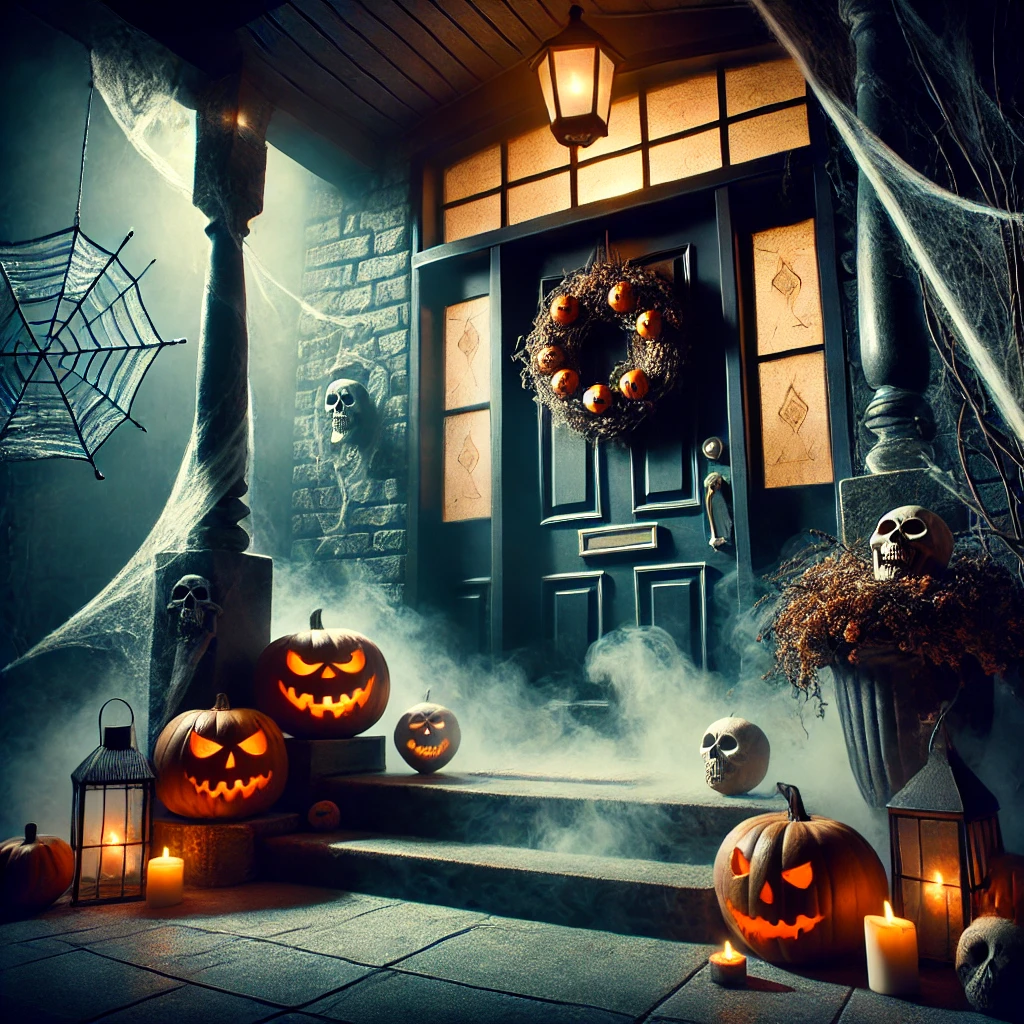DIY Haunted House: Step-by-Step Guide for Home
Are you ready to make your home spooky for Halloween? Our guide will show you how to create a scary experience. You’ll learn about eerie lighting, fog machines, creepy props, and sound effects.
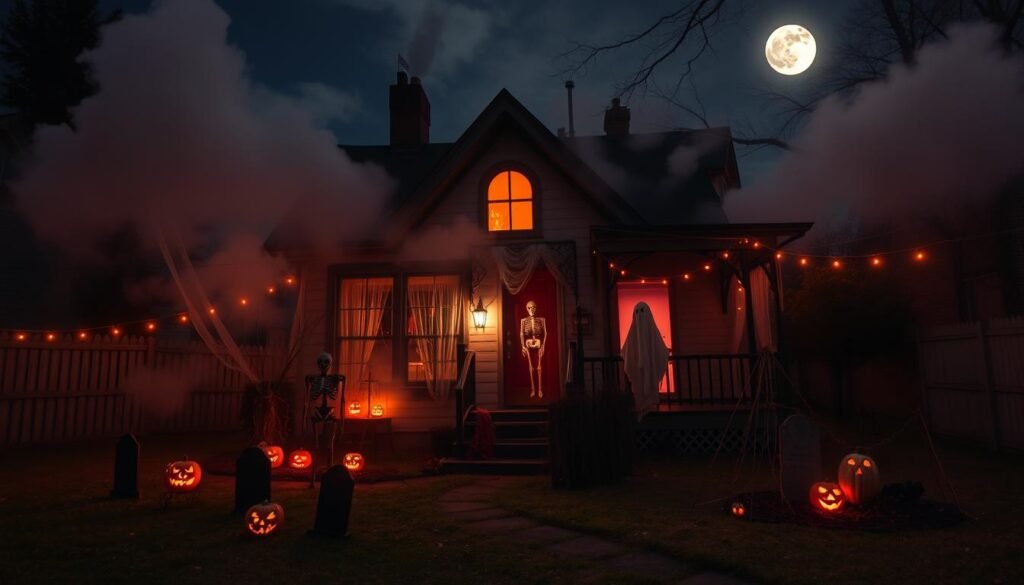
Hosting a Halloween party or just want a scare? This guide will help you set up each room. You’ll find out how to pick the best Halloween decorations and scare your guests safely. With creativity and DIY spirit, you can make a haunted house that’s unforgettable.
Let’s start making your DIY haunted house! By the end, you’ll know how to make a scary experience that will haunt your guests’ dreams.
Key Takeaways
- Learn how to create a haunted house at home with our step-by-step guide
- Discover tips for choosing the perfect spooky home decor and haunted house props
- Master the art of eerie lighting and special effects to create a truly terrifying atmosphere
- Safely scare your guests with strategically placed jump scares and creepy soundscapes
- Transform your home into a spine-chilling haunted house that will leave your guests screaming for more
Planning Your Haunted House
Creating a great haunted house needs careful planning. Think about the details before decorating and setting up scares. Here are key things to consider for your haunted house design.
Setting a Date and Time
Pick a date for your haunted house, like October or Halloween. Start planning a few weeks early. This gives you time to get materials, decorate, and practice.
Think about the best time for your event. Look at when your guests are free.
Determining Your Target Audience
Consider the age and likes of your guests. This helps you choose the right scares and decorations. For different ages, you might have special areas or paths.
| Age Group | Scare Level | Decoration Ideas |
|---|---|---|
| Young Children (3-7) | Mild, minimal scares | Cute ghosts, friendly witches, pumpkins |
| Older Children (8-12) | Moderate, some startle scares | Skeletons, zombies, haunted portraits |
| Teens and Adults (13+) | Intense, more frightening scares | Creepy dolls, bloody scenes, jump scares |
Choosing a Theme and Tone
Choose a theme for your haunted house. Options include a haunted mansion, a killer’s lair, or an abandoned asylum. Think about the tone you want, like scary or funny.
For a twist, make a cute setting that turns scary as you go through.
With your audience, theme, and tone in mind, plan your haunted house. Think about the layout, haunted house sounds, and scares to make it real.
Designing the Haunted House Layout
When making a haunted house, plan your path well. Choose which parts of your home to decorate. You can decorate key rooms or the whole house inside and out. A good layout keeps guests scared and interested all the way through.
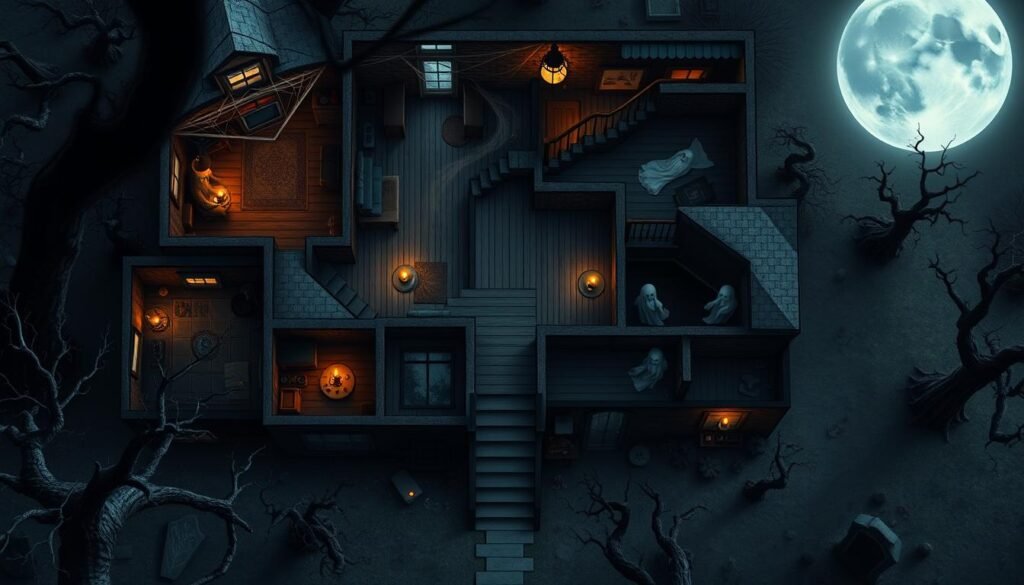
Creating a Haunted Path
For a great haunted house, think about your path’s flow. Sketch your home’s layout, picking rooms and hallways. Plan your scares and decorations to match the path. Use signs, arrows, or spooky lights to guide guests.
Utilizing Rooms and Hallways
Every room and hallway is a chance for a scary scene. Pick rooms for different themes or scares. For example, a bedroom can be a creepy doll room, or a bathroom a bloody crime scene.
Use hallways to build suspense. Add dim lights or sudden scares to keep guests guessing.
“The key to a successful haunted house layout is to keep your guests guessing. Mix up the scares and surprises throughout the path to ensure a thrilling experience from start to finish.” – Angela Colone, professional haunt designer
Incorporating a Maze
A haunted maze can make your house even scarier. Use boxes, cloth, or hay bales for an outdoor maze. Plan and build your maze a week before the event.
Decorate it with scary props and lights. Make sure to mark the exit for safety.
| Maze Material | Approximate Cost |
|---|---|
| Cardboard boxes | $5-$10 per box |
| Black plastic sheeting | $20-$30 for a 10′ x 100′ roll |
| Hay bales (for outdoor mazes) | $5-$10 per bale |
| PVC pipes and connectors | $100-$200 for a basic structure |
Plan well to make a haunted house guests will remember. Use rooms, hallways, and mazes. Always think about safety and have fun designing your spooky space!
Creating an Eerie Atmosphere
To make your DIY haunted house really scary, you need the right feel. Use smart lighting, special effects, and sounds. This will turn your home into a place that will scare your guests a lot.
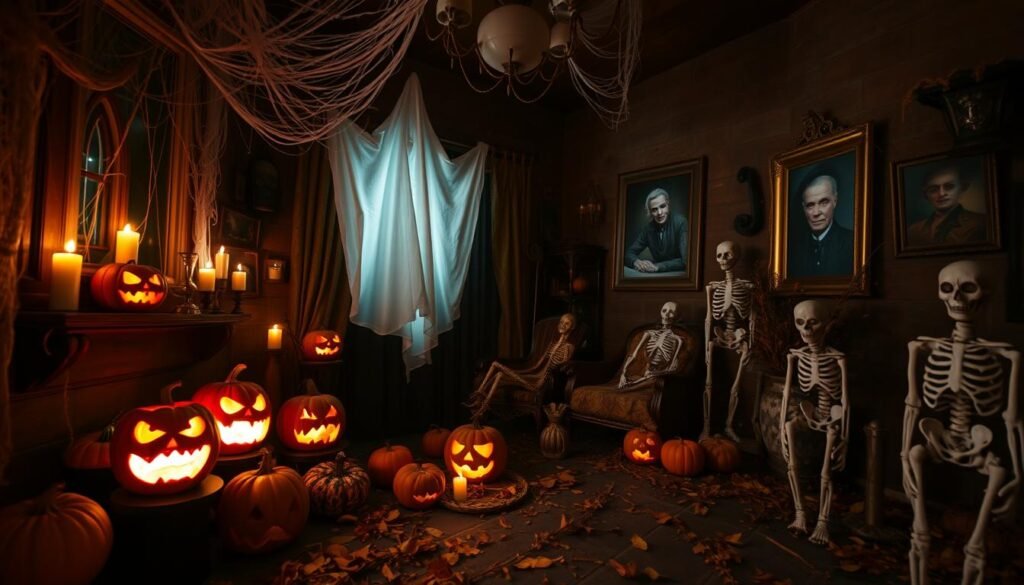
Lighting Techniques for a Spooky Ambiance
Lighting is key for a spooky mood. Turn down the lights and use green or red bulbs for a creepy feel. Add cobwebs and rubber bats for more scare.
Spotlights can make spooky shadows on walls. Use flickering candles or LED ones for a spooky glow. But remember, safety first, no real flames.
Using Special Effects: Fog Machines and Strobe Lights
Special effects can really scare your guests. Fog machines make the air thick and spooky. Dry ice cauldrons create fog for a ghostly look.
Strobe lights can confuse and scare people. But be careful with those who don’t like flashing lights.
| Special Effect | Occurrence Rate |
|---|---|
| Fog Machines | 80% |
| Strobe Lights | 10% |
| Blacklights | 5% |
| Projections | 3% |
| Scent Diffusion | 2% |
Crafting Spooky Soundscapes
Haunted house sound effects are very important. Timing is everything for sudden scares. Use different sounds in each room, like chainsaws or screams.
Be quiet sometimes to make scares more shocking. Play creepy music in the background to keep the scare going.
By combining smart lighting, special effects, and sounds, your DIY haunted house will be very scary. It will leave a big impression on your guests.
DIY Haunted House Props and Decorations
To make a spooky haunted house, you need the right props and decorations. You can make cool diy haunted house props and spooky decorations with a little creativity and some cheap materials. This will make your guests excited and a bit scared.

Budget-Friendly Prop Ideas
There are many cheap ways to make DIY haunted house props. Here are some ideas:
- Black candles with dripping hot glue wax
- Styrofoam tombstones
- Twisting foam trees
- Glow-in-the-dark paint for eerie, illuminated eyeballs
- Transforming old dolls into terrifying decorations with black paint and fake blood
Our updated guide shows that 14% of DIY haunted house ideas use everyday items like foam, paint, and glue. By using what you already have and buying cheap supplies, you can make lots of props without spending a lot.
Crafting Creepy Portraits and Haunted Mirrors
Creepy portraits and haunted mirrors add to the scare. To make creepy portraits:
- Paint disturbing images on canvas or poster board
- Frame the paintings in old, distressed frames
- Hang the portraits in your haunted house
To make haunted mirrors, paint spooky messages or images on the glass. Then, put flickering lights behind them. This will make your mirrors seem otherworldly and scary.
| Prop Idea | Materials Needed |
|---|---|
| Creepy Dolls | Old dolls, black paint, fake blood |
| Spooky Signage | Wood, paint, stencils |
| Eerie Lighting | LED lights, colored bulbs, dimmer switches |
Remember, the key to creating effective diy haunted house props and spooky decorations is to let your imagination run wild and have fun with the process.
By using a mix of cheap props, creepy portraits, and haunted mirrors, you’ll make a haunted house that’s unforgettable and scary. It will be a night to remember for all who dare to enter.
Recruiting and Coordinating Volunteers
To make your haunted house come alive, you need a team of volunteers. Ask friends, family, and community members to join in. They should love making things spooky. Give each volunteer a role to make things run smoothly and let everyone use their talents.
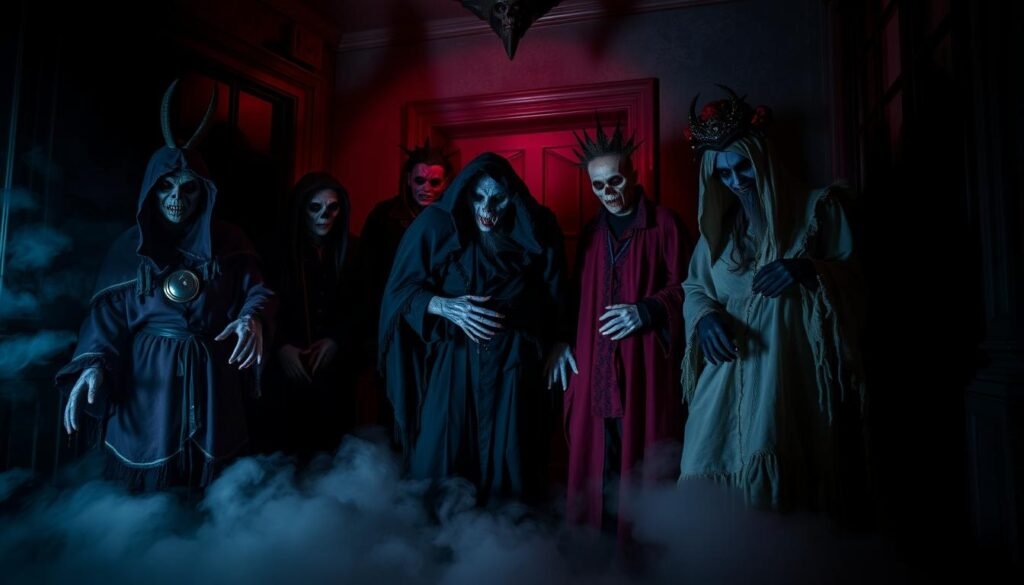
Assigning Roles and Responsibilities
Think about what each volunteer is good at when giving out roles. Some might be great at scaring people, while others are better at guiding guests. Here are some important roles:
- Scare Actors: These volunteers hide and scare guests when they least expect it.
- Tour Guides: Volunteers lead guests through the haunted house, making sure everyone knows where to go.
- Activity Managers: They handle interactive parts of the haunted house, like games.
- Makeup and Costume Assistants: Help with makeup and dressing actors in their costumes.
Make sure each volunteer knows their job and feels okay with it. Give them clear instructions for a fun and safe time for everyone.
Dressing Up in Spooky Costumes
Dressing up is one of the best parts of being a haunted house actor. Encourage them to be creative with their costumes. They can draw inspiration from horror movies or spooky versions of everyday people. Here are some tips for costumes:
- Choose costumes that fit your haunted house’s theme.
- Make sure costumes are comfy and let actors move easily.
- Use makeup and prosthetics to make costumes look even spookier.
- Add props like fake weapons or creepy accessories to make costumes more interesting.
| Costume Ideas | Makeup Suggestions |
|---|---|
| Ghostly Apparition | Pale skin, dark circles around eyes |
| Zombie | Decaying flesh, blood spatters |
| Creepy Clown | Exaggerated features, vibrant colors |
| Possessed Doll | Cracked porcelain skin, eerie eyes |
Remember, the key to a successful haunted house is the enthusiasm and dedication of your volunteers. With a well-coordinated team dressed in spooky costumes, you’ll create an unforgettable experience that will leave your guests screaming for more!
Incorporating Jump Scares and Scare Tactics
Jump scares and scare tactics are key for a scary haunted house. Timothy Haskell, a famous haunted house creator, says people fear what’s around the corner. This makes anticipation a big part of scares.
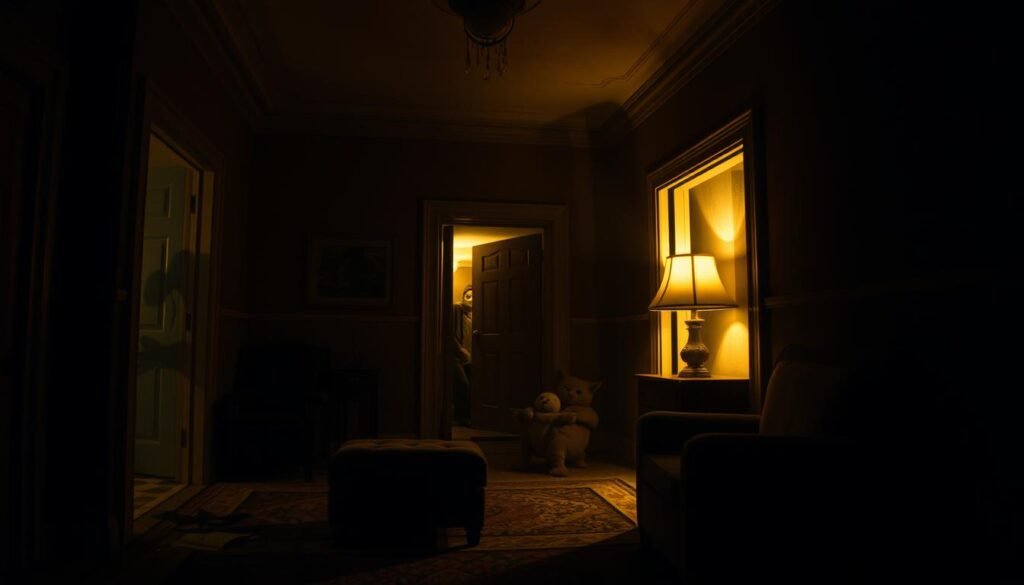
Actors can jump out of closets or grab shoulders for a scare. The surprise is what makes it scary. By placing scares well, you keep guests always on edge.
Setting up a room with a closed coffin and a skeleton surprise is effective. It taps into our fear of the unknown. For older guests, a chainsaw chase adds more fear.
“Engaging multiple senses, such as hearing, smell, touch, and even taste, can make the haunt more realistic and effective in scaring visitors.” – Timothy Haskell
Timing and placement are key for scares. Use music, sounds, and dim lights to add to the fear. Shadows can also help surprise guests.
| Scare Tactic | Effectiveness |
|---|---|
| Jump scares | 50% of haunted displays rely on jump scares for heightened fear effects |
| Themed areas | Themed areas within a haunted house can provide a variety of scares and enhance the overall experience |
| Engaging multiple senses | Engaging hearing, smell, touch, and even taste can make the haunt more realistic and effective in scaring visitors |
| Strategic actor placement | 80% of successful haunts employ a sufficient number of actors stationed strategically to manage scare levels |
The goal is to keep guests guessing. Mix jump scares, tactics, and sensory elements for a memorable experience. Your guests will want more.
How to Create a Haunted House at Home: A Step-by-Step Guide
Make your home a scary haunted house for Halloween. Our guide will help you create a spooky experience. Your guests will remember it forever.
Step 1: Plan Your Theme and Layout
First, pick a theme like a haunted asylum or a spooky carnival. Then, draw a layout. Think about how people will move and where scares will happen.
Step 2: Gather Materials and Props
Get all the things you need to make your house spooky. You’ll need:
- Fog machines or dry ice cauldrons for mist
- LED candles for a spooky light without fire
- Spooky items like old dolls and books
- PVC pipes, foam boards, skeletons, and cardboard for decorations
Step 3: Decorate and Set Up Scares
Decorate each room with your theme in mind. Use lights and sounds to make it spooky. Add jumpscares and secret spots for more scares. Use cardboard and glow-in-the-dark paint for cheap decorations.
| Room | Decoration Ideas | Scare Tactics |
|---|---|---|
| Entryway | Spooky archway, cobwebs, flickering lanterns | Animatronic jumping spider |
| Living Room | Haunted portraits, floating candles, eerie soundscape | Hidden actor in a closet |
| Dining Room | Halloween-themed food and drinks, mummified brie, bloody syringes | Actor dressed as a ghostly dinner guest |
Step 4: Recruit Actors and Assign Roles
Get friends and family to play characters. Give them costumes and tell them about their role. Teach them how to scare people.
Step 5: Test and Refine Your Haunted House
Do a test run before opening it. Check for any problems. Improve it based on what your test guests say. This will make it scarier.
“The key to a successful haunted house is attention to detail. From the moment guests step through the door, they should be transported into a world of terror and suspense.” – Sarah Thompson, professional haunted house designer
Follow this guide to make a haunted house that will scare your guests. Remember to keep it safe, have fun, and enjoy Halloween!
Safety Considerations for Your Home Haunt
Creating a spooky atmosphere is key for your DIY haunted house. But, safety is just as important. By following haunted house safety tips, you can make sure everyone has fun and stays safe. Let’s look at some important safety tips for your home haunt.
Fire Safety and Emergency Exits
Fire safety is a big deal when you’re setting up your haunted house. Pick decorations that won’t catch fire and keep them away from heat. Make sure all emergency exits are easy to find and clear. You should also have smoke detectors and fire extinguishers ready.
It’s also smart to have a plan for getting everyone out fast. Tell all your helpers about what to do in an emergency.
Ensuring Proper Lighting and Visibility
Dim lighting adds to the spooky feel, but safety comes first. Make sure there’s enough light for guests to move around safely. Use glow-in-the-dark tape or lights to show the way.
Think about putting in emergency lights that turn on when the power goes out. Have staff or volunteers help guests through dark spots. This way, everyone can have a good time without worrying about safety.
By focusing on these safety tips, you can make a fun and safe haunted house. A great haunted house is all about creativity, safety, and making sure everyone has a good time. With careful planning and a focus on safety, your DIY haunted house will be the best in the neighborhood this Halloween!
FAQ
How far in advance should I start planning my haunted house?
Start planning your haunted house a few weeks early. This lets you get supplies, decorate, and find volunteers.
What are some popular haunted house themes?
Popular themes include haunted mansions and abandoned asylums. You can also mix genres for a unique theme.
How can I create a spooky atmosphere in my haunted house?
Use dim lights and green bulbs for a spooky feel. Add fog and strobe lights for more scare. Create a creepy soundscape with music and sound effects.
What are some budget-friendly DIY haunted house props?
Make props like black candles and styrofoam tombstones. Use black paint and fake blood on dolls. Add glow-in-the-dark eyeballs for a spooky touch.
How can I effectively incorporate jump scares in my haunted house?
Actors can jump out of closets or grab shoulders. Use a closed coffin for a big scare. For older guests, a chainsaw chase works well.
What safety considerations should I keep in mind when creating a home haunt?
Make sure decorations are fire-safe and away from heat. Mark exits clearly and keep them open. Have staff to watch and a plan for emergencies.
To make your haunted house truly unforgettable, use high-quality decorations and props that create an immersive experience. For more ideas and the best DIY Halloween party decoration kits, check out our detailed guide here.
